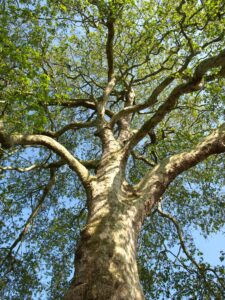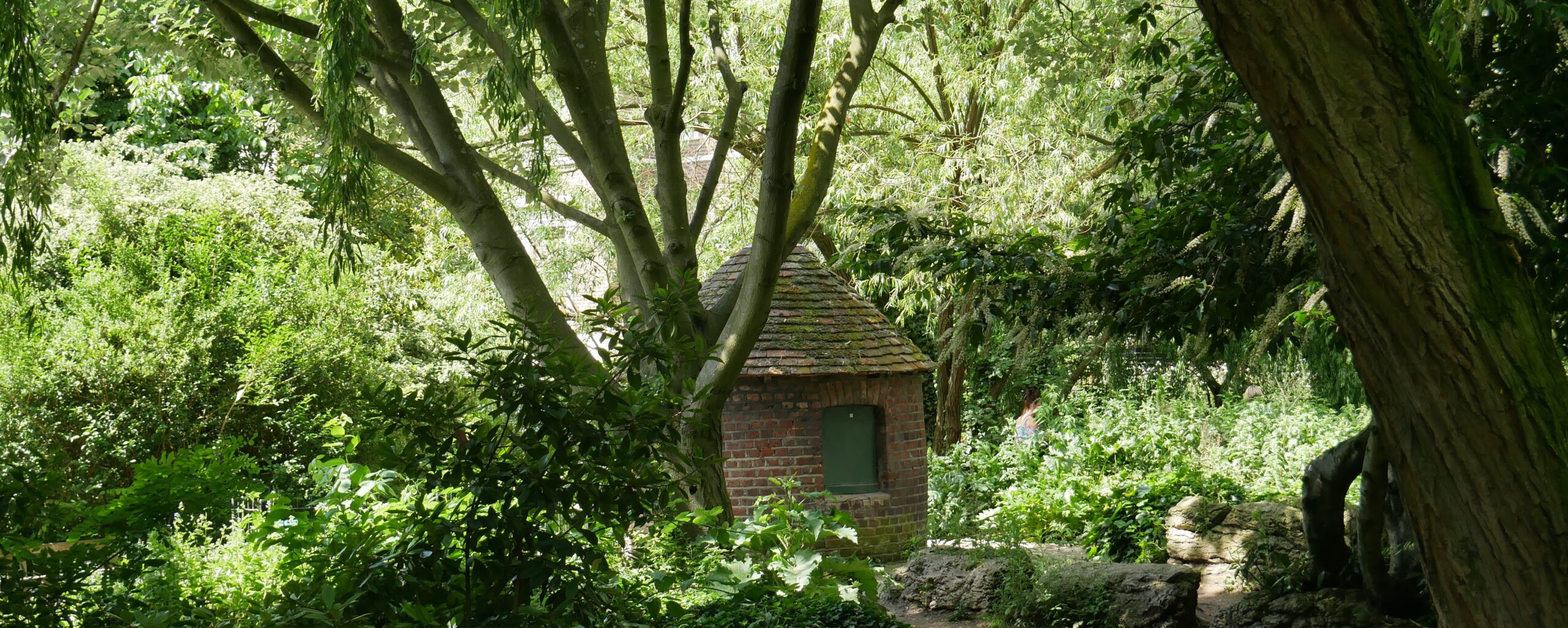
Caring for trees in the conservation area
We all have a ‘duty of care’ to look after and protect our trees. The Canonbury Society tree team works to ensure that our trees are safeguarded, as well encouraging appreciation of them.
Every tree in the Canonbury Conservation Area, including those in rear gardens, is officially protected. The Council requires notification in writing, six weeks prior to carrying out any works on trees including pruning, lopping, felling or uprooting. For more information visit the Islington Council website here or contact the Council’s tree officers on 020 7527 7569. You can find a list of approved professional tree care work contractors on the Council’s list here.
Our tree team reviews and monitors all applications for tree work in the conservation area where many trees, including those in rear gardens, are protected by a tree preservation order (TPO). We encourage tree planting for a continuing stock of mature trees, and promote appreciation of our local trees on instagram Trees of Canonbury.
Some 40,000 trees are growing in Islington, creating a tree canopy cover of 25 percent compared to the London 21 percent across London. In Canonbury, the tree canopy cover is 34.8 percent. We are working alongside the Council to increase the number of trees and enlarge the tree canopy cover.
Putting our trees back on the map
by James Robinson Tillett, Tree Planting and Engagement Manager at Islington Council
Albeit a compact and dense borough, Islington is rich with people and nature. Amidst the landscape our trees stand tall, as the borough’s largest living assets, resilient and diverse, with a quite remarkable history ‒ but where are these icons of the borough?
Like us, trees have entered a digital age after being uploaded to Islington’s website and what better way to celebrate these new, old or bygone trees in the 21st century than putting them back on the map!
Through our live Tree Map you can browse over 46,000 records dating back over 10 years. This intuitive resource is designed for anyone wanting to investigate our data and get to know their local trees by name (or at least the species) ‒ lets learn more!
What to do?
Get online and search ‘Islington Tree Map’ or click the link below: https://trees.islington.gov.uk/Trees/Map. You should see this see this:
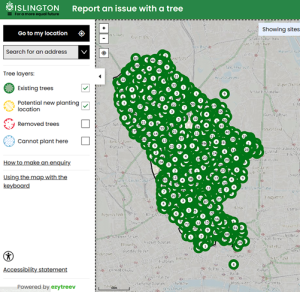
There are multiple layers to pick from, including current trees, removed trees or even potential places for trees. You can view their Eco Benefits impacts, estimated value and more – just search a location or click the GPS icon. Note that the Conservation Areas and TPOs are not there yet!
Not enough information? – Please raise an enquiry and ask!
Please do get involved and share your passion for trees, we would love to hear how much you appreciate your local tree – you can help test our enquiry system and share that passion!
Furthermore, if you’re keen to donate towards our tree care in your area, you can do that via our website here.
Many thanks from the Tree Planting Engagement Team!
Gavin Rees’ Top Trees
Gavin Rees was a tree officer with Islington Council for six years from 2017. The
Society worked closely with him and valued his guidance and expertise. He was
responsible for managing the planning application process for trees protected by
Tree Preservation Orders and Conservation Area legislation. Here he presents his
favourite trees in the Canonbury Ward.
Right Tree, Right Place
By Alison Barlow
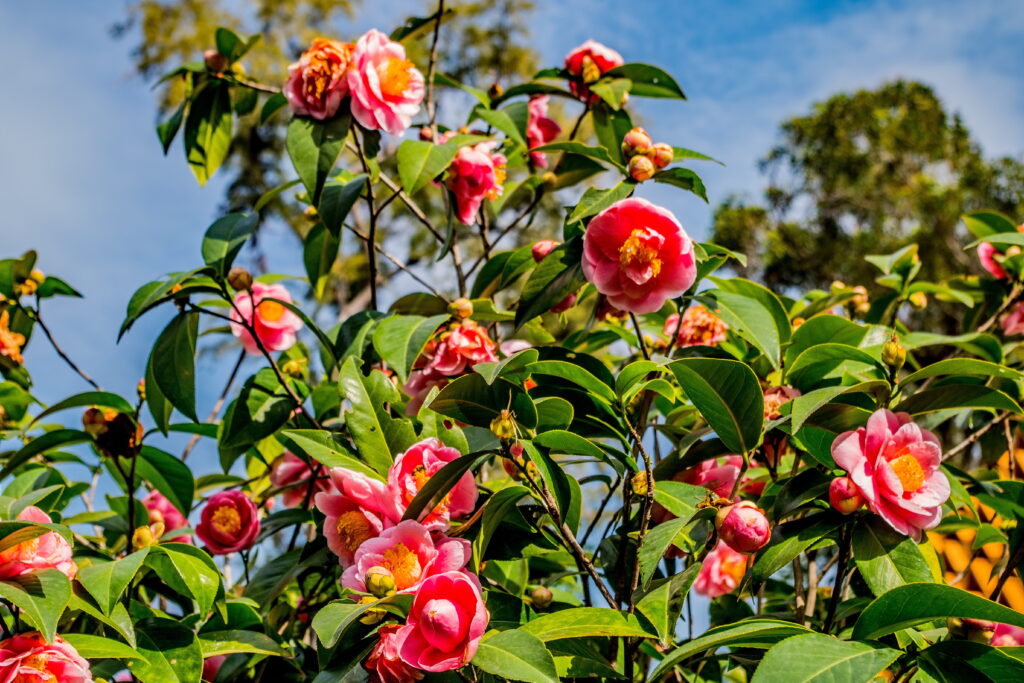
Camellia
When I moved into my Canonbury house over 40 years ago, the garden had, along with two grassed hillocks which turned out to be concealing rubble and an old iron bedstead, a weeping willow tree. It was small, seemed to have been fairly recently planted, and was clearly unhappy. Little wonder; the soil is free draining silt over a deep layer of gravel which is pretty much the opposite of the river banks willows like. If I had left it, the willow would probably have died within a year or two. I dug it up, wrapped the roots in a sack and donated it to someone living near a lake.
Fortunately (leaving aside the limes planted by the Victorians with the intention they be kept pleached and the sycamores self-sown in the WWII Blitz), most Canonbury tree planting errors are not on this scale. But it is not unusual to see a tree which has clearly outgrown its owner’s intentions and become misshapen in efforts to cut it back to size.
It is much better to choose something which will keep to the intended size. Do your research (RHS website is always reliable) and buy from a reputable nursery to ensure that what you get is what is says on the label.
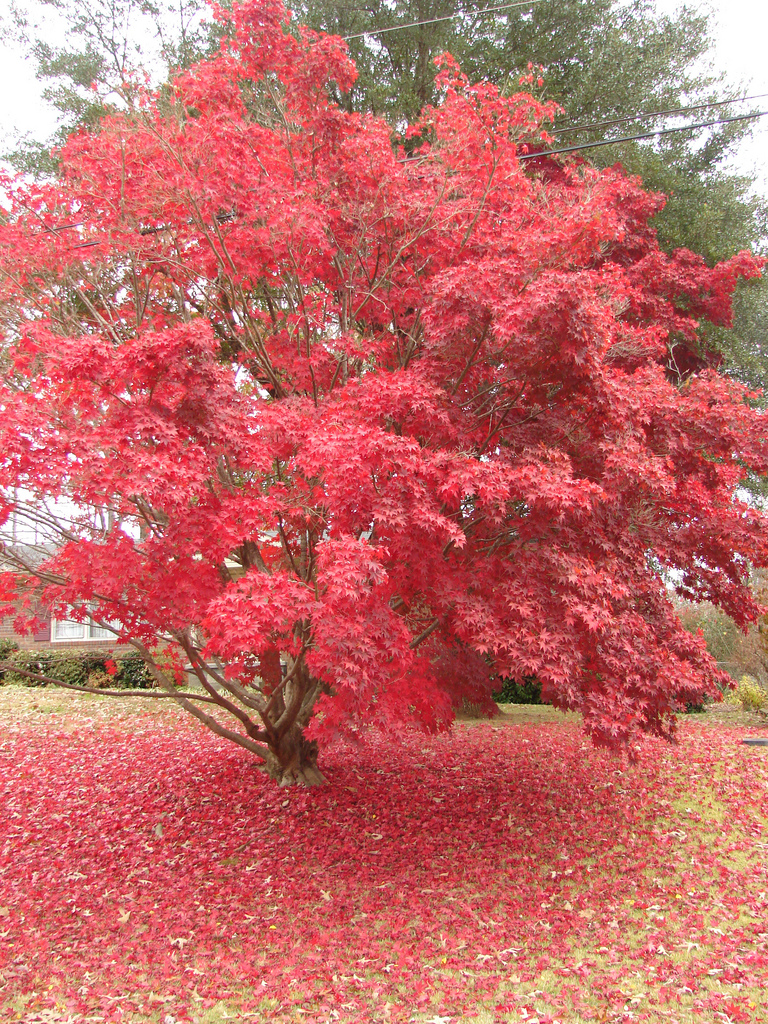
Acer palmatum (Japanese Maple)
A few recommendations:
Flowering Cherry There are endless varieties in white and shades of pink with single or double flowers. RHS has a list recommended for smaller gardens https://www.rhs.org.uk/garden-inspiration/plants-we-love/cherry-trees-for-small-gardens. Some are compact enough to grow in containers. Avoid the Wild Cherry prunus avium which reaches 40’ or more and produces numerous suckers.
Amelanchier More of a large bush than a tree. Grows slowly to about 14’ with copper coloured young foliage, small white flowers in spring and good autumn colour.
Sophora tetraptera “kowhai” Slowish growing small tree to about 13’ with evergreen foliage in a graceful open shape and spectacular bright yellow flowers in spring.
Hammamelis (Witch Hazel) another large shrub, height and spread each around 10’, winter flowering and fragrant.
Acer palmatum (Japanese Maple) grows to about 12’, green or purple leaves. There is a splendid example in St Jude Street (Mildmay, near St Jude’s church) which neatly fills a small front garden. Also compact forms 2’ – 3’.
Acer griseum (Paperbark Maple) slow growing to around 14’ has peeling cinnamon coloured bark which is an attractive winter feature.
Buddleia alternifolia the fountain buddleia (quite unlike the ubiquitous B. davidii ) arching stems of lilac coloured flowers in June approx. 10’ x 10’.
Camellia there are almost as many cultivars of camellia as roses, most are largish bushes but they can be trained to a tree shape. They flourish in Islington which has slightly acid soil, but not quite acid enough for rhododendrons or azaleas.
Eucryphia a tall shrub eventually becoming a small tree about 15’ tall. White flowers late summer to early autumn.
Magnolia Magnolia soulangeana is the most popular, mainly because it is the only magnolia which flourishes in alkaline as well as acid soil. It has a spreading shape and reaches around 20’ wide and high. M. stellata is the smallest with cultivars ranging from 3’ to 10’ often multi- stemmed. Evergreen M. grandiflora is not a good choice. It will eventually reach 40’ or more and, although its flowers are very large, they are not plentiful.
Birch (Betula) Silver birch (Betula pendula) is always popular since it is never dense enough to produce deep shade in summer. Betula jacquemontii has even whiter bark which makes it a good feature in winter and is generally a better choice, especially when grown multi-stemmed which tends to reduce the height.
Cercis siliquastrum (Judas Tree) slow growing to around 15’ with clusters of pink ore white flowers on the branches before the heart shaped leaves appear.
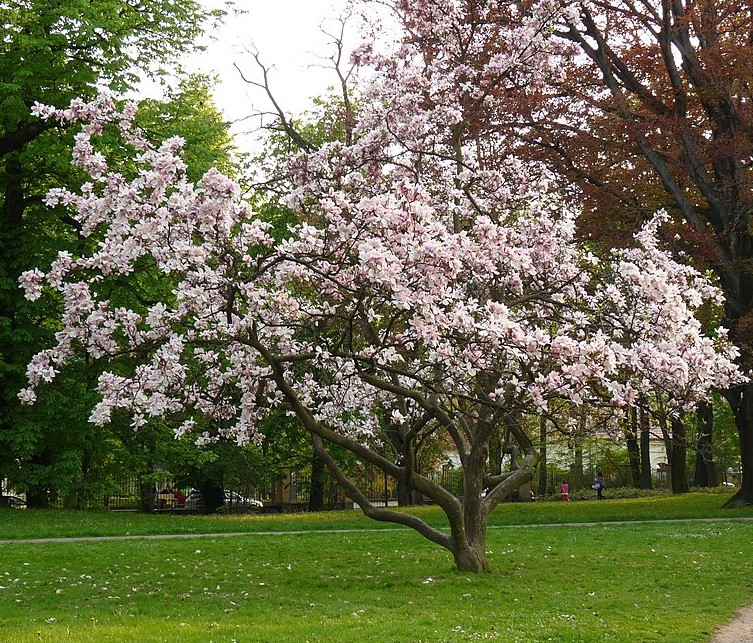
Magnolia soulangeana
There is concern about the effect of ivy growing on trees. Read one resident’s worries and advice from the Council’s Tree Preservation Officer.
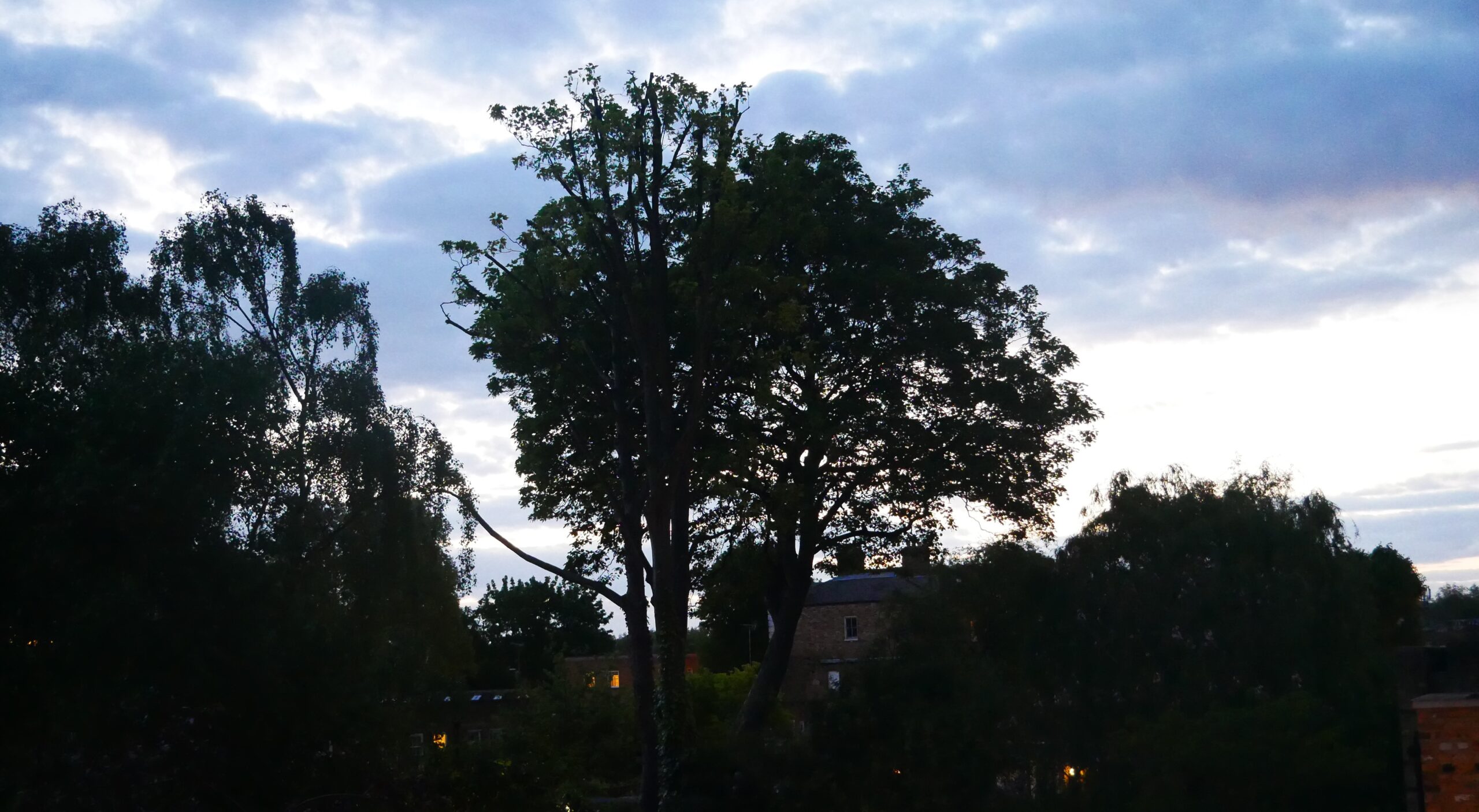
Forgotten Corners and Tree Pits
Islington Gardeners Forgotten Corners is a scheme which supports residents who want to garden neglected pieces of land. These are usually owned by the Council, but can be privately owned. Either way, permission to garden needs to be sought.
Tree pits or tree gardens are type of Forgotten Corner created in the bare soil around a street tree. The Council encourages them, subject to guidelines found on their website, and it is important to follow these to avoid damaging the tree. All maintained tree pits have to be identified with a band of red ribbon wrapped around the tree.
The sites are usually difficult, are often trampled on, littered, and subject to wind damage, theft and vandalism. The plants also must be as tough as nails. But we persevere, because the results can be very rewarding.
For more advice about Forgotten Corners visit: islingtongardeners.org.uk, and click on the ‘Other’ tab of the home page. Also, see the tree pit maintenance form and tree pit guidance pdf on the Council’s website: www.islington.gov.uk/
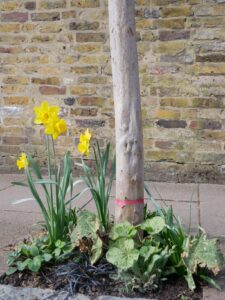
London Plane Trees
London Plane Trees are the most common street tree in the capital. A London Plane in St Mary Magdalene’s Churchyard was valued recently by CAVAT (Capital Asset Value for Amenity Trees) at £1.6m, making it the highest value tree in the country. Its girth is over seven metres and it’s approximately 300 years old.
